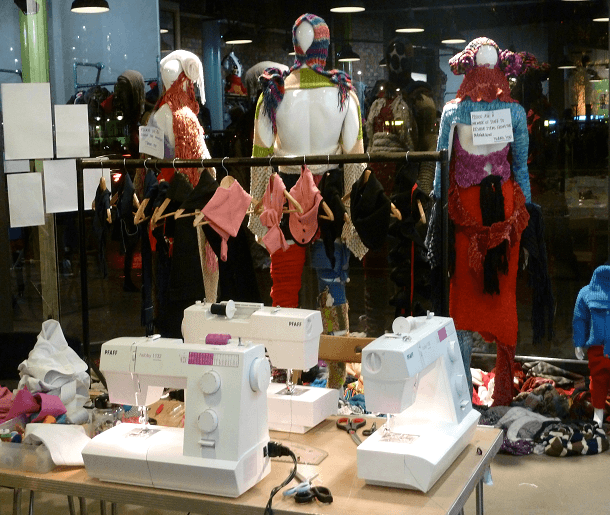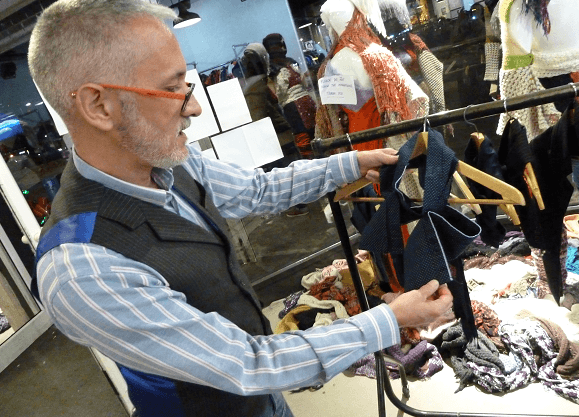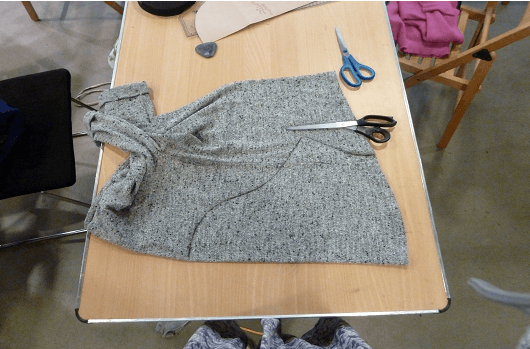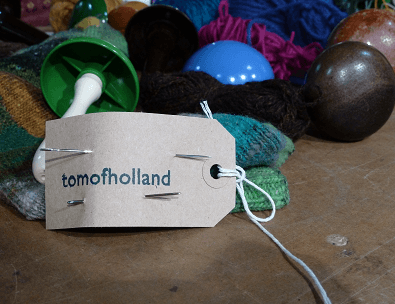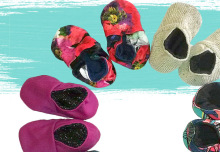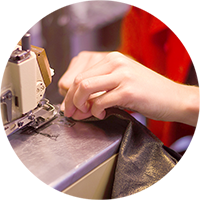In February this year WRAP launched SCAP (Sustainable Clothing Action Plan). This encourages big players in the UK clothing market to pledge a reduction of 15% in carbon, water and landfill waste. If big name brands can find time to jump on the second hand hype surely Lucy Palmer, a nanny and full time student, can too? Ripping, re-hemming and botch-jobbing her wardrobe to within an inch of its life, she pledged to source 95% of her wardrobe second hand through TRAID’s #secondhandfirstweek.
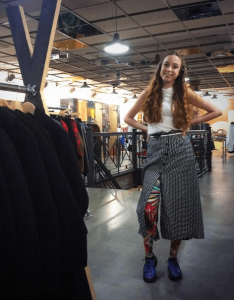
Day One
Having the accurate premonition that I would have forgotten all I learnt about sewing machines back when I was a fashion student in 2008 I enrolled in an evening at the Fara Workshop’s ‘Rework Your Wardrobe’ class.
Upon first glance, all sewing classes are cripplingly expensive. The Fara class takes three hours and came in at £50. I can hear the sharp intake of breath emitting from my fellow students but comparatively, this is cheap. Fara is a charity based shop and knowing that a chunk of my hard earned cash would be going to orphaned children in Romania made it easy to part with.
The shop is closing when you arrive so you get that exciting sense of being invited to a lock-in. Hannah Brooke, seamstress at Fara Workshop, taught me how to take my dress up four inches. The process of re-hemming meant I had to use an over-locking machine (turn over any sleeve on a jumper or cotton cardigan and you’ll see the kind of stitch I’m referring to). The overlocker is a terrifying to a novice like myself. Imagine four metallic spider legs ending in a blur of needles that, with a press of your foot, all furiously clack. You have to guide the fabric underneath all that and there’s a blade on the side to slice off loose fabric.
This machine is nothing compared to industrial scale machines; in Chinese garment factories a shocking 40,000 fingers are severed every year and I’m starting to see how. The dress received five compliments throughout the day. I cannot remember the last time so many people complimented my outfit; Antiform leggings made from reclaimed material, the reworked dress and my cosy blue TRAID coat.
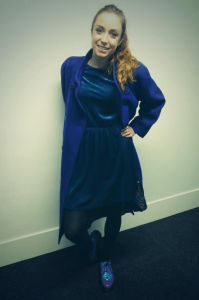
Day Two
The average UK household holds £4,000 worth of clothes. 30% of these clothes haven’t even been worn in the last year. That’s a staggering £1,200 worth of clothes just waiting to be sold. I took ten garments hiding in the back of my wardrobe to Lucy Harford at Bang Bang Clothes Exchange in SoHo to see what I could make.
Lucy is the Gordon Ramsay of the clothes exchange world. She can spot a snag, pull or bobble a mile off. From the ten garments I’ve brought to her, only two are sellable. Saving best till last I unfold my Aunt’s flamenco skirt by Workers for Freedom. According to my Aunt WFF were as big as Vivienne Westwood back in the 80’s, “I know whose collection this is! People are starting to collect this stuff again. I can make you an offer on it now if you like?”
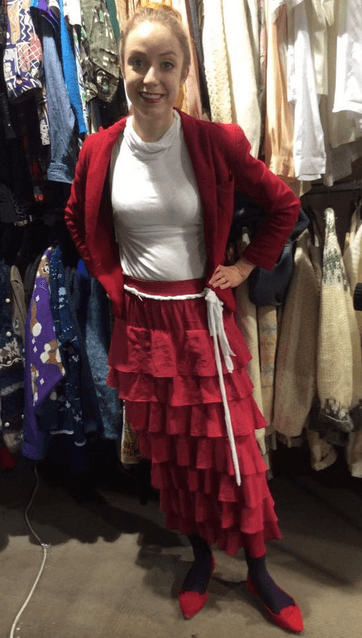
I hold my breath…am I about to hand over an old skirt and receive a fat wad of cash? Unfortunately all she can offer is £15. The fast fashion industry has hit shops like hers hard. “Being fashion conscious is not just about thinking about the amount of water used to make one kilo gram of cotton. The whole thing hits much closer to home. I can’t fill my rails with Primark priced garments. I’m trying to do a good thing but I’ve got a landlord who wants his rent paid.”
I chose not to part with the WFF skirt but to take in the waist and wear it for day two of the fashion challenge. I pair it with a man’s top from a bin bag of clothes a friend was throwing. It needs tweaking somewhat, so I rip the thing to shreds and knot it into shape. Unfortunately it is painfully obvious I have botched this one. I need a sewing machine.
 Day Three
Day Three
It’s 7am and I am destroying one of my favourite dresses, a black and white checked number bought in Blue Rinse in Leeds for a fiver. The skirt part has frayed up the thigh so the best thing for it is to turn it into a top/skirt combo.
Carefully snipping away with my kitchen scissors I then fold and press (using hair straighteners). Just as I’m about to start hand stitching I look and see it’s already 9.30am and I’m late for university. I leave the top frayed. When stitched to the skirt it looked of a respectable length but post chop it has cruelly shrunk to the size of something I would feel more comfortable dressing the baby in. It’s too late to do anything about it so I pair it with some high-waisted trousers from TRAID and a crop top from my aunty to try and hide the fact that there is very little by way of clothing going on up there.
I really need a sewing machine. Asking around, there’s a friend who lives on the other side of London who has one she never uses. Brilliant. There are better ways to spend two hours than lugging a sewing machine thing on foot, bus, tube and over ground but it’s free, so no complaining. Then it’s down to Dalston for another #secondhandfirst organised event.
TRAID’s window dresser Francesco Colucci gave a talk about his job (mashing clothes together on mannequins using pins). He hits on a brilliantly bonkers idea solving a query I’ve had for a while; how can I reuse my laddered tights?
“You put a bag in the tights and make a hat.” He says, as if it’s the most normal thing in the world. I am up till the early hours of the morning hand stitching together a head-piece that looks incredibly bizarre but I am too exhausted to worry about the looks it’ll get the following day.
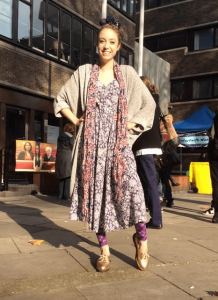
Day 4. Headpiece made from tights. Second-hand cardi. My mum’s old Laura Ashley dress reworked at the Fara Workshop.
Day Five
The average amount of clothes that fill the average UK household takes a gargantuan 1,000 bathtubs of water to produce. On day five I accidently add a sink load of water to that by hand dying a Karl Lagerfeld jacket purple.
To assuage my guilt I head off to the Shepherds Bush store in the evening with an un-loved jumper. David Mumford (a tailor who makes unisex reworked clothes) taught me how to make two scarves in under an hour. I made one my size and another small enough for the baby I look after to wear.

Day Six
After a full day of university, picking the children up from school and getting them off to bed I dash off to an evening course with Tom van Deijnen, Master Mender. I’m slightly concerned at the start as darning needles turn out to be extra long sharp pointy things and I am at focus blurring levels of exhaustion.
Luckily Tom of Holland is full of infectious energy. He told lovely stories about the repair work he gets, “I once repaired a jumper for a woman that was knitted by her mum. They’d never gotten along well but knitting was one thing they had in common. It was their last link between them after her mother had passed away, it was very special and I felt so privileged to repair such a valuable garment.”
The lifespan of most garments is estimated by WRAP to be 2.2 years but mending and darning can extend that. Tom flits between all 10 of us with commendable patience and soon I feel like Wendy lady.
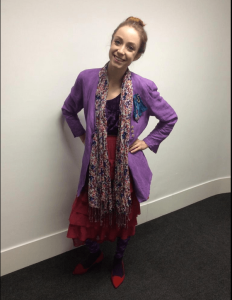
Day 7. Shoes and scarf from Mary’s Living and Giving Shop, leggings by Antiform, skirt by Workers for Freedom reworked at the Fara Workshop, second-hand Karl Largerfeld jacket dyed purple, reworked top (spliced from a dress), brooch made with Tom of Holland darn, broken jewellery and offcuts from the week’s trimmings.
Valuing our clothes, Tom believes, is essential to improving the industry’s supply chain. This is where TRAID comes into it’s own. As Sarah Klymkw, Education Officer at TRAID, explains, “By reusing the nations unwanted clothes in the UK, we are then able to generate a profit to fund international development projects within the textile supply chain.” From protecting the maternal rights of garment workers in Lesotho to supporting organic cotton farmers in Benin, they are a leading example to the fashion world that changes at every stage of garment production are possible.
Statistics from;
WRAP – Valuing our Clothes: The true cost of how we design, use and dispose of clothing in the UK 2012
URS: Review of Data on Embodied Water in Clothing Summary Report 2012


